Clean Code
Motivation
Readability of code is important
- Code is much more often read than written
- Your write code for the next human to read it, not for the compiler/interpreter/computer!
Object-Oriented Design (OOD)
A design strategy to build a system “made up of interacting objects that maintain their own local state and provide operations on that state information.”
[Sommerville]
SOLID principles: Five principles of good OO design
- Single Responsibility Principle (SRP)
- Open Closed Principle (OCP)
- Liskov Substitution Principle (LSP)
- Interface Segregation Principle (ISP)
- Dependency Inversion Principle (DIP)
Single Responsibility Principle (SRP)
“There should never be more than one reason for a class to change.“ — R. Martin
Each responsibility deals with one core concern
- It may also deal with further (cross-cutting) concerns
Bad smell: Big class (~ >200 LOC, >15 methods/fields)
- Useful refactoring: Extract class
Benefits:
- Code is easier to understand
- Adding/modifying functionality should affect few classes
- Risk of breaking code is minimised
Insertion: Command-Query-Separation
- Separate commands (actions) from simple queries (requests)
- Reason
- Commands are expected to have side effects on an object’s state
- Queries should not change the state of an object
- Appropriate designs are simpler to understand and easier to test
Open Closed Principle (OCP)
“Software entities (classes, modules, functions, etc.) should be open for extension, but closed for modifi-cation.” — R. Martin, paraphrasing B. Meyer
💡 Idea: Modify behaviour by adding new code, NOT by changing old code
Strongly related to the “Information Hiding Principle”
Example: Drawing a list of shapes using a switch statement
for (Shape shape : ShapeList) switch (shape.getType()) { case SQUARE: square.draw() case CIRCLE: circle.draw() }Needs to be modified for new shapes 🤪
Solution: use abstractions to keep the function open for extension
for (Shape shape : ShapeList) shape.draw();
Liskov Substitution Principle (LSP)
“Functions that use pointers or references to base classes must be able to use objects of derived classes without knowing it.”
— R. Martin
Example
Square is-a Rectangle? Only in a mathematical sense!
Square can-NOT-substitute Rectangle, because it offers limited behaviour (
setWidthandsetHeightare dependent)
LSP is related to B. Meyer‘s Design by Contract (DbC):
“When redefining a routine [in a derivative], you may only replace its precondition by a weaker one, and its postcondition by a stronger *one.” *
— B. Meyer
- In our case, rectangle’s
setWidthpostcondition:width = wandheight = h - Square’s
setWidthpostcondition:width = wandheight = w - Only weaker preconditions and stronger postconditions are allowed, as only they preserve substitutability. It is not allowed to change conditions to arbitrarily different ones
Possible solution according to Liskov:
Square/Rectangle can-substitute Shape,
if Shape collects
less specific behaviour
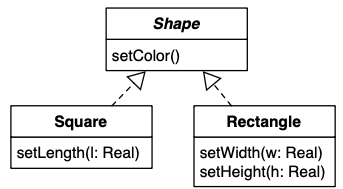
Alternative: Drop
height = hfrom Rectangle’s postcondition
Interface Segregation Principle (ISP)
“Clients should not be forced to depend upon interfaces that they do not use.”
— R. Martin
Interfaces should be kept as lean as possible
- High cohesion: Interfaces should only be concerned with single concepts
- Interface pollution: Interfaces should not depend on other interfaces just because a subclass requires those
- Interfaces should be separated if used by different clients
- Refactorings: Extract interface/superclass
Example:
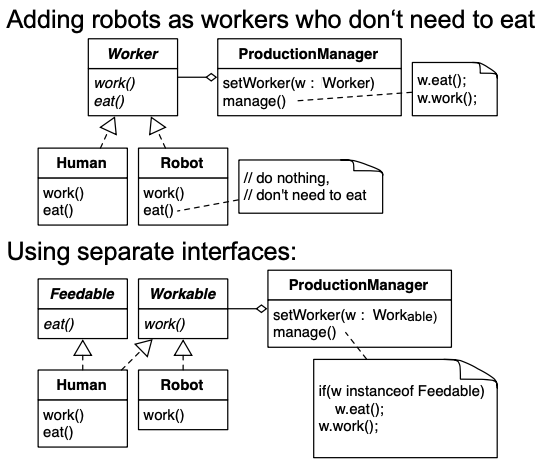
Dependency Inversion Principle (DIP)
“A. High level modules should not depend upon low level modules. Both should depend upon abstractions.
B. Abstractions should not depend upon details. Details should depend upon abstractions.”
— R. Martin
Example:
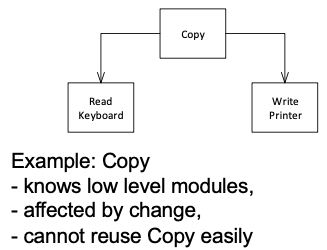
Better design:
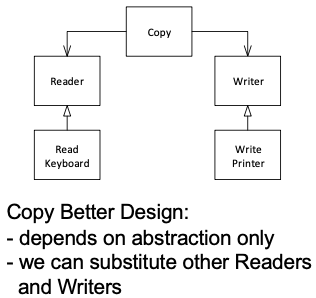
Why “Inversion”?
An interface has been used to invert the dependency between packages
But in general: Add abstract concept that both classes A and B depend on
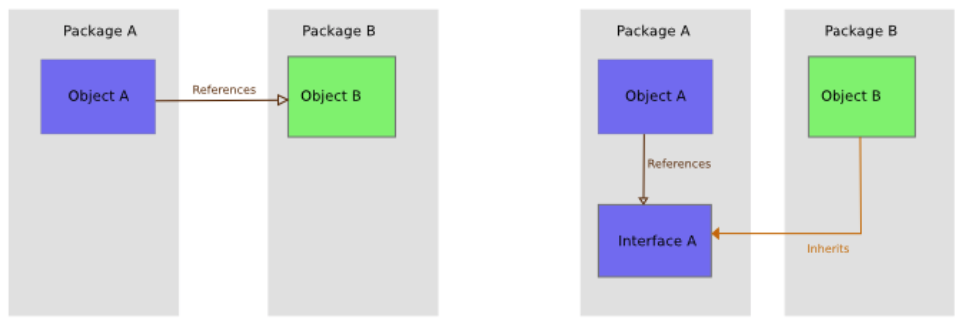
More Principles
Law of Demeter (don’t talk to strangers)
A module should not know about the innards of the objects it manipulates.
Corresponds to the bad smell “Message Chains”:
value = getClassA().getClassB(). ... .getNeededValue();👆 Ties code to particular class structure, which is likely to break. :cry
Rule: A method
mof a classCshould only call the methods ofCAn object created by
mAn object passed as an argument to
mAn object held in an instance variable of
C
Example:
Violation
class Motor { public void startEngine() { // start the motor } }class Car { public Motor motor; public Car() { motor = new Motor(); } }class Driver { public void drive() { Car myCar = new Car(); myCar.motor.startEngine(); // violation!!! } }Solution
class Car { private Motor motor; public Car() { motor = new Motor(); } public void getReadyToDrive() { this.motor.startEngine() } }class Drive { public void drive() { Car myCar = new Car(); myCar.getReadyToDrive(); } }
Boy Scout Rule
„Leave the campground cleaner than you found it!“ — The Boy Scouts of America
Code degrades as time passes
We seldom start with a greenfield
Being honest:
To the code
To your colleagues
To yourself about the code
Refactor your code before checking it in
Principle of Least Surprise
Any function or class should implement the behaviours that another programmer could reasonably expect
Also called principle of least astonishment (POLA)
“If a necessary feature has a high astonishment factor, it may be necessary to redesign the feature.”
- If obvious behaviour remains unimplemented, readers and users…
- no longer depend on their intuition about function names
- fall back on reading internals
Coding Conventions
Naming
Standardised (with respect to a project or team)
Meaningful, i.e. clear for everyone
Intention-revealing:
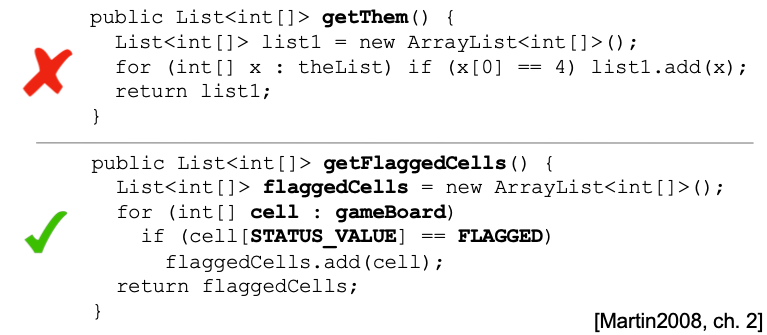
Make meaningful distinction and avoid disinformation
- Hints on context
- Hints on types
- Certain prefixes
Avoid noninformation
- Except for well-accepted cases (e.g.
ias a loop counter)
- Except for well-accepted cases (e.g.
Commenting
“Don’t comment bad code—rewrite it.“
— B. W. Kernighan, P. J. Plaugher
Good comments are
- explaining
- Legal issues
- Performance issues
- Train of thought
- Intent
- Algorithms
- Good comments are warning
- Of consequences
- Over importance
- Good comments are informative
- Open issues, to-dos
Whenever possible, use well-named code to tell what is done
Intermediate variables explaining steps
Extra methods encapsulating expressions

Formatting
- Visually representing levels of cohesion
- Vertical openness between concepts,
- e.g. declarations
- e.g. add blank lines after imports or after a method is finished
- lines that are related should be written densely together
- Horizontal openness
- to accentuate operators / operator precedence
- to separate parameters
- use spaces to emphasize elements and indent to make scopes visible
Don’t repeat yourself (DRY)
Do not duplicate pieces of code!
- Copy & paste decreases…
- Maintainability: Losing track of copies
- Understandability
- Code is less compact
- An identical concept needs to be understood multiple times
- Evolvability
- Need to find and modify all copies, When removing bugs or changing behaviour
- Duplicated code fosters errors and inconsistencies
Keep it simple, stupid (KISS)
“Make everything as simple as possible, but not simpler”
— Albert Einstein
Good code is easy to understand by anybody
Good code addresses the problem adequately
For example, if an
IEnumerableis suitable, do not use anICollectionor even anIListTechniques which help ensure that your code is understandable by others:
Code reviews
Pair programming
You ain’t gonna need it (YAGNI)
Only implement required features!
Featurism is costly:
unrequested features need to be tested, documented
over-engineered systems sacrifice maintainability, as they are overly complex (KISS)
Beware of optimisations!
- Often merely treat symptoms
- Too costly to be done prematurely
Single Level of Abstraction (SLA)
Newspaper metaphor:
Good newspaper articles are well-ordered
Navigation with details increasing:
- headline (very high abstraction)
- text with synopsis (high abstraction)
- rest (details)
Statements within a function should be at the same abstraction level
- if not, extract expressions/statements of higher detail into an own method
Functions in a class: The abstraction level should decrease depth- first when reading from top to bottom
Refactoring
If it stinks, change it.
Methods tend to grow during development
Bad odour (smell) of a long method arises
What to do? Extract cohesive parts into new methods
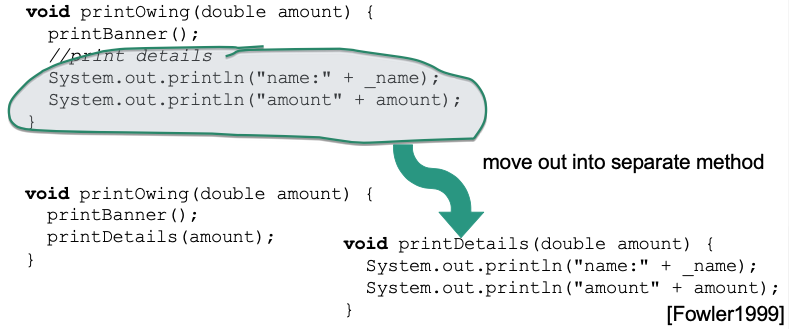
What is Refactoring?
A „disciplined technique for restructuring an existing body of code, altering its internal structure without changing its external behavior.“
— M. Fowler
The First Rule in Refactoring
Refactor with tests only!
- Good tests help to prevent introducing bugs into the program through refactoring
Bad Smells
Bad code smells: symptoms for deeper problems
Long method: having code blocks lead by comments
- 👨⚕️Cure: Extract Method: extract commented block
Duplicated code
Feature envy: class A excessively calls another class B’s methods
- 👨⚕️Cure: parts of A’s methods want to be in class B
- Extract Method: extract code block calling class B
- Move Method: move extracted part to class B
- 👨⚕️Cure: parts of A’s methods want to be in class B
Data class: class merely holds data (“dumb data holder”)
- 👨⚕️Cure: enforce information hiding principle, collect functionality
- Encapsulate field: getter/setter instead of public access
- Remove setting method: only for read-only values
- Move method: collect functionality implemented elsewhere
- think about responsibilities of the class
- 👨⚕️Cure: enforce information hiding principle, collect functionality
Large/God class: class tries to do too much
Inappropriate intimacy: class has dependencies on implementation details of another class
…
More catelog see: https://www.refactoring.com/catalog/index.html
When to Refactor?
It is not that simple to find out when to refactor
So-called “bad smells” in code may give a good indication when refactoring is worthwhile
More general guidelines
- when you find yourself looking up details frequently
- what was the order of the method parameters again?
- where was this method again and what does it do?
- when you feel the need to write a comment
- try to refactor the code so that the comment becomes superfluous
- when you find yourself looking up details frequently
Limitations
- May influence performance negatively 🤪
- However, it is recommended to do the refactoring first
- and the performance tuning on the cleaner code afterwards
Appendix
Separation of Concerns (SoC)
Each module should be focused on a single concern.
- 👍 Benefits
- Loose coupling, high cohesion
- Better testability: each test stays focused on one module
- Some concerns may crosscut a system‘s core concerns
- Typical crosscutting concerns:
- Tracing/Logging
- Security
- Transactionality
- Caching
- Aspect Oriented Programming (AOP) provides adequate concepts
- Typical crosscutting concerns:
Order of Implementation
For the implementation (and unit testing later) always try to move from the least-coupled to the most-coupled classes
- avoids unnecessary creation of “stubs”
Example
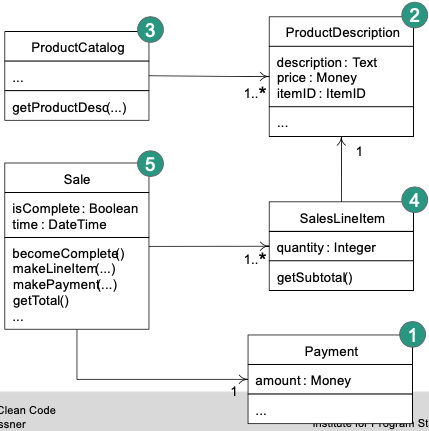
Use a Version Control System
History of commented changes
Shared working in a team, even on same artefacts Branching and merging
Tagging versions as pre-release etc.
Reverting to previous revisions
reduces fears of breaking code
encourages a programmer‘s willingness to refactor code
Test First
Test-Driven Development
Clean tests should follow the F.I.R.S.T. rules
Fast: to run them frequently
Independent: A failing test does not influence others
Repeatable: in any environment, so there is no excuse for failing tests
Self-Validating: Tests either pass or fail automatically
Timely: Tests are written right before production code
Tests should follow same standards as production code
- and be executed in a continuous manner
- so-called continuous integration
- reduces fear of breaking code
- and be executed in a continuous manner
Static Code Analyses
Classes of metrics
Duplication (detection of DRY violation)
Unit tests (test coverage should be > 90%)
Complexity (avg. LoC per class)
Potential bugs
Coding rules
Comments
Architecture & design
Code Reviews
Explaining your code to others helps…
- Detecting errors and unclean passages
- Spreading knowledge through a team,
- esp. to less experienced colleagues
about design principles
about further aspects of the system under development
Refactoring helps to instantly apply suggestions, so follow-up ideas can be given in one session
- Works only in small groups with few opinions
- In larger groups, design reviews are better suitable